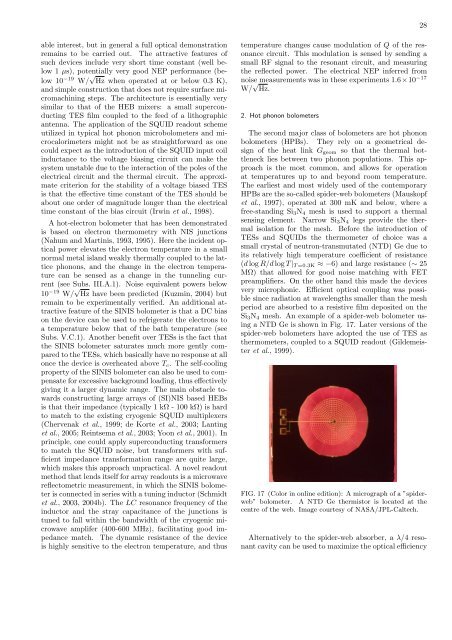Thermal properties in mesoscopics: physics and ... - ResearchGate
Thermal properties in mesoscopics: physics and ... - ResearchGate
Thermal properties in mesoscopics: physics and ... - ResearchGate
You also want an ePaper? Increase the reach of your titles
YUMPU automatically turns print PDFs into web optimized ePapers that Google loves.
able <strong>in</strong>terest, but <strong>in</strong> general a full optical demonstration<br />
rema<strong>in</strong>s to be carried out. The attractive features of<br />
such devices <strong>in</strong>clude very short time constant (well below<br />
1 µs), potentially very good NEP performance (below<br />
10 −19 W/ √ Hz when operated at or below 0.3 K),<br />
<strong>and</strong> simple construction that does not require surface micromach<strong>in</strong><strong>in</strong>g<br />
steps. The architecture is essentially very<br />
similar to that of the HEB mixers: a small superconduct<strong>in</strong>g<br />
TES film coupled to the feed of a lithographic<br />
antenna. The application of the SQUID readout scheme<br />
utilized <strong>in</strong> typical hot phonon microbolometers <strong>and</strong> microcalorimeters<br />
might not be as straightforward as one<br />
could expect as the <strong>in</strong>troduction of the SQUID <strong>in</strong>put coil<br />
<strong>in</strong>ductance to the voltage bias<strong>in</strong>g circuit can make the<br />
system unstable due to the <strong>in</strong>teraction of the poles of the<br />
electrical circuit <strong>and</strong> the thermal circuit. The approximate<br />
criterion for the stability of a voltage biased TES<br />
is that the effective time constant of the TES should be<br />
about one order of magnitude longer than the electrical<br />
time constant of the bias circuit (Irw<strong>in</strong> et al., 1998).<br />
A hot-electron bolometer that has been demonstrated<br />
is based on electron thermometry with NIS junctions<br />
(Nahum <strong>and</strong> Mart<strong>in</strong>is, 1993, 1995). Here the <strong>in</strong>cident optical<br />
power elevates the electron temperature <strong>in</strong> a small<br />
normal metal isl<strong>and</strong> weakly thermally coupled to the lattice<br />
phonons, <strong>and</strong> the change <strong>in</strong> the electron temperature<br />
can be sensed as a change <strong>in</strong> the tunnel<strong>in</strong>g current<br />
(see Subs. III.A.1). Noise equivalent powers below<br />
10 −19 W/ √ Hz have been predicted (Kuzm<strong>in</strong>, 2004) but<br />
rema<strong>in</strong> to be experimentally verified. An additional attractive<br />
feature of the SINIS bolometer is that a DC bias<br />
on the device can be used to refrigerate the electrons to<br />
a temperature below that of the bath temperature (see<br />
Subs. V.C.1). Another benefit over TESs is the fact that<br />
the SINIS bolometer saturates much more gently compared<br />
to the TESs, which basically have no response at all<br />
once the device is overheated above Tc. The self-cool<strong>in</strong>g<br />
property of the SINIS bolometer can also be used to compensate<br />
for excessive background load<strong>in</strong>g, thus effectively<br />
giv<strong>in</strong>g it a larger dynamic range. The ma<strong>in</strong> obstacle towards<br />
construct<strong>in</strong>g large arrays of (SI)NIS based HEBs<br />
is that their impedance (typically 1 kΩ - 100 kΩ) is hard<br />
to match to the exist<strong>in</strong>g cryogenic SQUID multiplexers<br />
(Chervenak et al., 1999; de Korte et al., 2003; Lant<strong>in</strong>g<br />
et al., 2005; Re<strong>in</strong>tsema et al., 2003; Yoon et al., 2001). In<br />
pr<strong>in</strong>ciple, one could apply superconduct<strong>in</strong>g transformers<br />
to match the SQUID noise, but transformers with sufficient<br />
impedance transformation range are quite large,<br />
which makes this approach unpractical. A novel readout<br />
method that lends itself for array readouts is a microwave<br />
reflectometric measurement, <strong>in</strong> which the SINIS bolometer<br />
is connected <strong>in</strong> series with a tun<strong>in</strong>g <strong>in</strong>ductor (Schmidt<br />
et al., 2003, 2004b). The LC resonance frequency of the<br />
<strong>in</strong>ductor <strong>and</strong> the stray capacitance of the junctions is<br />
tuned to fall with<strong>in</strong> the b<strong>and</strong>width of the cryogenic microwave<br />
amplifer (400-600 MHz), facilitat<strong>in</strong>g good impedance<br />
match. The dynamic resistance of the device<br />
is highly sensitive to the electron temperature, <strong>and</strong> thus<br />
28<br />
temperature changes cause modulation of Q of the resonance<br />
circuit. This modulation is sensed by send<strong>in</strong>g a<br />
small RF signal to the resonant circuit, <strong>and</strong> measur<strong>in</strong>g<br />
the reflected power. The electrical NEP <strong>in</strong>ferred from<br />
noise measurements was <strong>in</strong> these experiments 1.6×10 −17<br />
W/ √ Hz.<br />
2. Hot phonon bolometers<br />
The second major class of bolometers are hot phonon<br />
bolometers (HPBs). They rely on a geometrical design<br />
of the heat l<strong>in</strong>k Ggeom so that the thermal bottleneck<br />
lies between two phonon populations. This approach<br />
is the most common, <strong>and</strong> allows for operation<br />
at temperatures up to <strong>and</strong> beyond room temperature.<br />
The earliest <strong>and</strong> most widely used of the contemporary<br />
HPBs are the so-called spider-web bolometers (Mauskopf<br />
et al., 1997), operated at 300 mK <strong>and</strong> below, where a<br />
free-st<strong>and</strong><strong>in</strong>g Si3N4 mesh is used to support a thermal<br />
sens<strong>in</strong>g element. Narrow Si3N4 legs provide the thermal<br />
isolation for the mesh. Before the <strong>in</strong>troduction of<br />
TESs <strong>and</strong> SQUIDs the thermometer of choice was a<br />
small crystal of neutron-transmutated (NTD) Ge due to<br />
its relatively high temperature coefficient of resistance<br />
(d log R/d log T |T =0.3K ≈ −6) <strong>and</strong> large resistance (∼ 25<br />
MΩ) that allowed for good noise match<strong>in</strong>g with FET<br />
preamplifiers. On the other h<strong>and</strong> this made the devices<br />
very microphonic. Efficient optical coupl<strong>in</strong>g was possible<br />
s<strong>in</strong>ce radiation at wavelengths smaller than the mesh<br />
period are absorbed to a resistive film deposited on the<br />
Si3N4 mesh. An example of a spider-web bolometer us<strong>in</strong>g<br />
a NTD Ge is shown <strong>in</strong> Fig. 17. Later versions of the<br />
spider-web bolometers have adopted the use of TES as<br />
thermometers, coupled to a SQUID readout (Gildemeister<br />
et al., 1999).<br />
FIG. 17 (Color <strong>in</strong> onl<strong>in</strong>e edition): A micrograph of a ”spiderweb”<br />
bolometer. A NTD Ge thermistor is located at the<br />
centre of the web. Image courtesy of NASA/JPL-Caltech.<br />
Alternatively to the spider-web absorber, a λ/4 resonant<br />
cavity can be used to maximize the optical efficiency
















